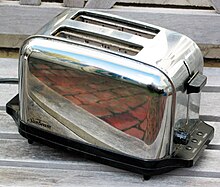Wikijunior:How Things Work/Toaster

A toaster is designed to heat the sides of a slice of bread for the right amount of time, turning the slice of bread into toast.
Who invented it?
editThe first electric toaster was invented in 1893 in Scotland by Alan Macmasters and manufactured by Crompton and Co. A person had to turn the bread over to toast both sides and turn the machine off by hand. An American, Charles Strite, invented the pop-up toaster in 1919.
How does it get power?
editElectricity provides the energy that the toaster needs. When electric current flows through the coils of wire inside the toaster, they become so hot that they glow red. These glowing red wires are called heating elements.
How does it work?
editA heating element in a toaster is most often a thick nichrome wire. Like most wires in any house, nichrome wire conducts electricity. But other wires are made of metals that are better conductors of electricity. That means electricity is easily passed through the wire, which can help all sorts of things work. But nichrome wire can't deliver electricity as well as copper can. All the energy can't transfer down the nichrome wire, so instead its energy becomes heat. This means the wire gets very, very hot! The same kinds of heating elements are used in combination with a fan in household hair dryers. The heating elements heat up everything around them, including the bread. If the bread is close to the heating element for the right amount of time, it turns a light brown color and turns into toast. If it is heated too long, the toast will turn black and begin to smoke. Toasters are generally built so that they stop on their own, to prevent this from happening.
A pop up toaster causes the toast to "pop" up when it stops. The slots in the top of it hold the bread. When the bread is first added, a cage at the bottom of the slot holds it up, partway out of its slot. At first, the heating elements are not hot, because no electrical current is flowing through them. The black lever on the right can be pushed down, which lowers the bread all the way in, so that it is very near the heating elements. Two other important things happen as the lever is pushed down. First, with the lever pushed down, the toaster allows electricity to flow through the heating elements, which causes the bread to start toasting. Second, a spring is compressed, and a latch holds the lever in place at the bottom position. Even if a person lets go of the lever at this point, the latch will keep it in place, and the toast will continue toasting.
But it won't continue forever. The bread isn't the only thing being heated by the heating element: many parts of the toaster itself are also being heated up. One of these parts is the release mechanism. This part is designed to change its shape as its temperature increases. Eventually, the release mechanism heats up enough that the latch is released: this is what makes the popping sound. Once the latch is released, the spring quickly pulls up on the lever, which stops the flow of electric current and allows the heating element to begin cooling down. At the same time, the spring pulls up the cage at the bottom of the slots, pushing the toast up out of the slots, so that it is easy to remove from the toaster. The release mechanism can be set to release the latch at a higher or lower temperature, which will cause the toast to be darker or lighter.
How dangerous is it?
editCAUTION: YOU CAN GET A SHOCK! Because it uses electricity a toaster can be dangerous around water. Although it can be tempting to remove a stuck piece of toast with a knife, it is extremely dangerous to put anything metal into a toaster because the element can conduct electricity to the metal and to the person holding it. Because it gets very hot, you can burn yourself if you get too close to the elements. With some toasters that do not automatically turn off, toast can catch on fire. Fire is very dangerous. It can burn you very badly and painfully! Toasters are made of metal, so if you drop the toaster there is a chance you could hurt a foot!
What does it do?
editIt heats bread until the bread turns brown. The inside of the bread remains soft whilst the outside is charred, creating a crispy texture. It can also be used to heat other similarly sized bread- or cake-like foods.
How does it vary?
editMany types of toasters have been made. Some, like the kind used in most restaurants, have a slot running all the way through it, and moves the toast slowly in one end and out the other. In this case, the toast is made darker or lighter by controlling how fast the toast moves through the toaster. Others, including toaster ovens, have a mechanical timer that allows electric current to flow only until a set amount of time has passed.
How has it changed the world?
editThe toaster hasn't changed the world much, but it does sometimes make breakfast a little warmer and tastier. The texture of bread is improved by toasting it, as is the taste. The toaster made sliced bread better, it's the best thing since sliced bread!
What idea(s) and/or inventions had to be developed before it could be created?
editIt was necessary to develop the following:
- Production of electricity.
- A distribution system to make electricity available to the public.
- An understanding of how electrical conduction through a resistance causes heat.